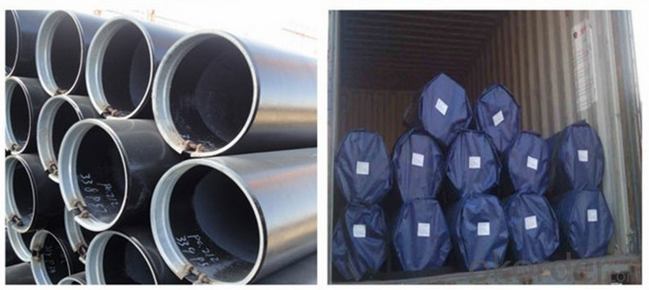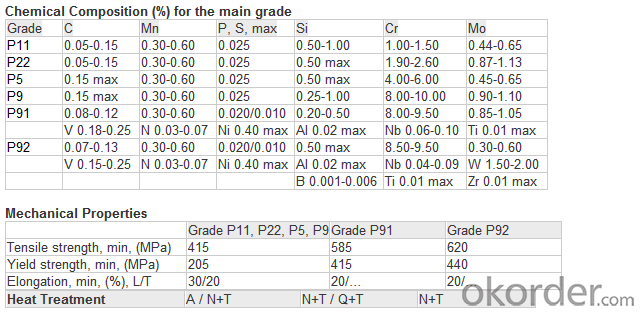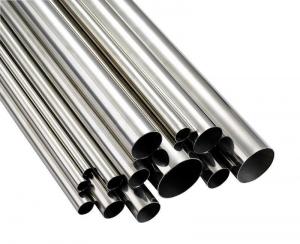Seamless Ferritic Alloy-Steel Pipe for High-Temperature Service in 2015
- Loading Port:
- Shanghai
- Payment Terms:
- TT OR LC
- Min Order Qty:
- 5000 kg
- Supply Capability:
- 10000 kg/month
OKorder Service Pledge
OKorder Financial Service
You Might Also Like
Description:
(1) nominal wall and minimum wall seamless ferritic alloy-steel pipe intended for high-temperature service. Pipe ordered to this specification shall be suitable for bending, flanging (vanstoning), and similar forming operations, and for fusion welding.
(2)Each length of pipe is subjected to the hydrostatic test and examined by a non-destructive examination method in accordance to the required practices. The range of pipe sizes that may be examined by each method is subjected to the limitations in the scope of the respective practices. The different mechanical test requirements for pipes has been passed.
(3)Ferritic steels are defined as low- and intermediate-alloy steels containing up to and including 10 % chromium.
ASTM A335 Seamless Alloy-Steel Pipe
Standard: BS 1139, BS 3059-2, JIS G3454-2007
Grade: 10#-45#, 15NiCuMoNb5, 10Cr9Mo1VNb
Detailed introduction to ASTM A335 seamless alloy steel pipe:
ASTM A335 seamless alloy steel pipe

Packaging Detail: | Bundle or Container or as per customers requirement. |
Delivery Detail: | within 25 days after we receive an irrevocable L/Cor 30% deposit |
ASTM A335 Seamless Alloy-Steel Pipe
Standard: BS 1139, BS 3059-2, JIS G3454-2007
Grade: 10#-45#, 15NiCuMoNb5, 10Cr9Mo1VNb
Detailed introduction to ASTM A335 seamless alloy steel pipe:
ASTM A335 seamless alloy steel pipe


FAQ:
1) why you chose us ?
Professional Manufacturer and supplier of Steel pipe
More than 14 years’ professional producing experience
We can get the lowest ex-factory prices. The price are quite reasonable and it is lower than our commercial peers. also, we can guarantee the qualities of our products.
BV, ISO certificates and SGS test can be provided to assure the quality of our products.
2) Our minimum order quantity:
10 Metric Tons or one 20ft or 40ft Container.
3) How about the Delivery Time?
The steel pipe will be produced since we getting your deposit by T/T or Your original L/C. For normal size, some stocks in our factory now, we can supply once you need.
4)What kind of payment does your company support?
T/T, 100% L/C at sight, Cash, Western Union are all accepted.
5) Do you charge for the samples?
According to our company principle, we just charge for samples, you pay for the freight /courier charge.
6) Main market:
Mid East, South America, Africa, Southeast Asia, India etc
FAQ:
1) why you chose us ?
Professional Manufacturer and supplier of Steel pipe
More than 14 years’ professional producing experience
We can get the lowest ex-factory prices. The price are quite reasonable and it is lower than our commercial peers. also, we can guarantee the qualities of our products.
BV, ISO certificates and SGS test can be provided to assure the quality of our products.
2) Our minimum order quantity:
10 Metric Tons or one 20ft or 40ft Container.
3) How about the Delivery Time?
The steel pipe will be produced since we getting your deposit by T/T or Your original L/C. For normal size, some stocks in our factory now, we can supply once you need.
4)What kind of payment does your company support?
T/T, 100% L/C at sight, Cash, Western Union are all accepted.
5) Do you charge for the samples?
According to our company principle, we just charge for samples, you pay for the freight /courier charge.
6) Main market:
Mid East, South America, Africa, Southeast Asia, India etc
- Q:Are stainless steel pipes resistant to chemical corrosion?
- Yes, stainless steel pipes are highly resistant to chemical corrosion.
- Q:Can stainless steel pipes be used for wastewater treatment systems?
- Yes, stainless steel pipes can be used for wastewater treatment systems. Stainless steel is a highly durable and corrosion-resistant material, making it an ideal choice for pipes in harsh environments such as wastewater treatment plants. These pipes can withstand the corrosive nature of wastewater, including the presence of chemicals and different pH levels. Stainless steel pipes also have a smooth surface, which helps to minimize the accumulation of waste and bacteria, ensuring the efficient flow of wastewater through the system. Additionally, stainless steel is easy to clean and maintain, making it a cost-effective and reliable choice for wastewater treatment systems.
- Q:What is the difference between electropolished and passivated stainless steel pipes?
- Electropolished and passivated stainless steel pipes are both surface treatments used to enhance the corrosion resistance and aesthetic appearance of stainless steel. However, there are some key differences between the two processes. Electropolishing is an electrochemical process that selectively removes a thin layer of material from the stainless steel surface. This process helps to remove impurities, contaminants, and embedded particles, resulting in a smooth and clean surface. Electropolishing also improves the microfinish of the stainless steel, reducing surface roughness and enhancing the overall appearance. This process can also improve the corrosion resistance of stainless steel by creating a passive chromium oxide layer on the surface. On the other hand, passivation is a chemical process that involves the application of an acid-based solution to the stainless steel surface. This solution helps to remove iron contaminants and other foreign substances from the surface, leaving behind a clean and passive layer of chromium oxide. Passivation helps to enhance the corrosion resistance of stainless steel by promoting the formation of a stable and protective oxide layer. In summary, electropolishing is an electrochemical process that removes a thin layer of material to create a smooth and clean surface, while passivation is a chemical process that removes contaminants and promotes the formation of a protective oxide layer. Both processes contribute to improving the corrosion resistance and aesthetics of stainless steel pipes, but they differ in the method used to achieve these results.
- Q:What are the dimensions and sizes of stainless steel pipes?
- The dimensions and sizes of stainless steel pipes can vary greatly depending on the specific application and industry requirements. Stainless steel pipes are available in various sizes, ranging from small diameter tubes of a few millimeters to larger pipes with diameters exceeding several feet. The dimensions of stainless steel pipes are typically specified by their outer diameter (OD), wall thickness, and length. The wall thickness can vary based on the intended use and pressure requirements of the pipe. Additionally, stainless steel pipes can be found in different shapes, such as round, square, or rectangular, to suit various installation needs.
- Q:How are stainless steel pipes measured?
- Stainless steel pipes are measured using two main parameters: outer diameter (OD) and wall thickness. The outer diameter refers to the measurement of the pipe's outer circumference, while the wall thickness indicates the thickness of the pipe's walls. These measurements are crucial in determining the suitability of the pipe for a specific application and ensuring compatibility with fittings and connectors. The dimensions of stainless steel pipes are typically expressed in millimeters or inches, and they can vary depending on the specific requirements of the project or industry standards. Accurate measurement is important to ensure proper fitting and functionality of the stainless steel pipes in various applications, such as plumbing, construction, or industrial processes.
- Q:Are stainless steel pipes suitable for food processing plants?
- Yes, stainless steel pipes are highly suitable for food processing plants. Stainless steel is a corrosion-resistant material that does not react with food or beverages, ensuring that there is no contamination. It is also easy to clean and maintain, making it ideal for maintaining strict hygiene standards in food processing facilities. Additionally, stainless steel pipes can withstand high temperatures and pressures, making them durable and long-lasting in food processing plant environments.
- Q:What is the maximum temperature that stainless steel pipes can handle?
- The maximum temperature that stainless steel pipes can handle depends on the specific grade of stainless steel being used. Generally, most stainless steel pipes can withstand temperatures up to 1500°F (815°C) without significant deformation or damage. However, there are specialized grades of stainless steel that can withstand even higher temperatures, reaching up to 2200°F (1204°C). It is important to consult the manufacturer or engineer for the specific stainless steel grade and intended application to determine the precise maximum temperature limit.
- Q:Can stainless steel pipes be used for gas pipelines?
- Yes, stainless steel pipes can be used for gas pipelines. Stainless steel is a highly durable and corrosion-resistant material, making it suitable for transporting various types of gases, including natural gas and propane. Stainless steel pipes also have high tensile strength, which allows them to withstand high pressure and temperature conditions that are often encountered in gas pipelines. Additionally, stainless steel is non-reactive, meaning it does not react with the gases being transported, ensuring the integrity and safety of the pipeline system. Overall, stainless steel pipes are a reliable choice for gas pipelines due to their strength, corrosion resistance, and ability to handle high-pressure environments.
- Q:How do you calculate the deflection of stainless steel pipes under load?
- To determine the deflection of stainless steel pipes under load, one can employ the theory of beam bending. This involves analyzing the pipe as a beam and applying the principles of bending moment and deflection. Initially, the moment of inertia (I) of the stainless steel pipe must be ascertained. This can be accomplished by utilizing a formula specific to the shape of the pipe. For instance, in the case of a circular pipe, the formula is as follows: I = π * (D^4 - d^4) / 64, where D represents the outer diameter and d represents the inner diameter of the pipe. Subsequently, the bending moment (M) acting on the pipe needs to be calculated. This is typically obtained from the applied load, which may take the form of a force, pressure, or weight acting on the pipe. The bending moment can be determined by multiplying the load by the distance between the applied load and the point of interest on the pipe. Once the moment of inertia (I) and bending moment (M) are known, the maximum deflection (δ) can be calculated using the following formula: δ = (M * L^2) / (E * I), where L represents the span length of the pipe and E represents the modulus of elasticity for stainless steel. It is crucial to note that these calculations assume the stainless steel pipe possesses perfect elasticity and a uniform material composition. Real-world factors, such as material properties, pipe geometry, and boundary conditions, may impact the accuracy of the computed deflection. Therefore, it is advisable to consult pertinent engineering codes, standards, or professional resources to ensure precise and safe calculations.
- Q:Can stainless steel pipes be used for outdoor handrails?
- Yes, stainless steel pipes can be used for outdoor handrails. Stainless steel is a popular choice for outdoor applications due to its durability, corrosion resistance, and aesthetic appeal. It is able to withstand harsh weather conditions, such as rain, snow, and UV exposure, without rusting or deteriorating. Stainless steel handrails also require minimal maintenance and can handle heavy usage. Therefore, they are a reliable and long-lasting option for outdoor handrails, providing safety and adding a modern touch to any space.
1. Manufacturer Overview |
|
|---|---|
| Location | |
| Year Established | |
| Annual Output Value | |
| Main Markets | |
| Company Certifications | |
2. Manufacturer Certificates |
|
|---|---|
| a) Certification Name | |
| Range | |
| Reference | |
| Validity Period | |
3. Manufacturer Capability |
|
|---|---|
| a)Trade Capacity | |
| Nearest Port | |
| Export Percentage | |
| No.of Employees in Trade Department | |
| Language Spoken: | |
| b)Factory Information | |
| Factory Size: | |
| No. of Production Lines | |
| Contract Manufacturing | |
| Product Price Range | |
Send your message to us
Seamless Ferritic Alloy-Steel Pipe for High-Temperature Service in 2015
- Loading Port:
- Shanghai
- Payment Terms:
- TT OR LC
- Min Order Qty:
- 5000 kg
- Supply Capability:
- 10000 kg/month
OKorder Service Pledge
OKorder Financial Service
Similar products
New products
Hot products
Related keywords





























